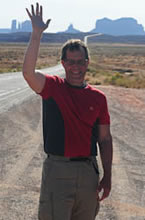Someone once said that Salem Heights School was home to every type of handicap there was, and I believe that to be true. We have a blind student, a child with no fingers, some on crutches or walkers and countless hearing impaired children, as we are the designated school in the district that integrates these kids into the regular classroom for half of the day. As a result of this diverse population, no one is ever considered odd; there are simply too many "different" kids around for anyone to be unusual. Another benefit for our kids is that they pick up quite a bit of sign language. My son, Taylor, in fact, often answers me with the sign for "yes" and "no" instead of speaking out loud. He, along with all the other children at Salem Heights, knows how to say his name in sign language, and how to applaud as deaf people do, which is to raise both hands and shake them.
My daughter Annie's class also has several hearing impaired children along with an interpreter. One of these children is named Kaitlinh, an adopted Vietnamese girl whose family moved from Albany to be at Salem Heights. As a baby in Vietnam, Kaitlinh experienced several severe ear infections. Well-meaning but incompetent doctors attempted to solve this problem by burrowing out all her inner ear tissue. As a result, Kaitlinh is profoundly deaf and always will be. The doctors also severed her facial nerves and she has forever lost the ability to smile or show any real facial expression at all. Her face remains still and her ears useless.
Annie and her friends have been practicing hard for the school talent show which occurred this morning so I knew ahead of time that Kaitlinh was going to do some type of dance. I was a bit curious about this, but then remembered that the deaf can sometimes keep a beat by feeling vibrations in the floor.
Kaitlinh came out dressed as a Polynesian hula dancer with furry palms in her hands. Her mother sat in front and directed her when to start and Kaitlinh did a surprisingly sophisticated dance for a four grader, hearing or not. She did great, except for one problem which was that she somehow lost communication with her mother on when to stop. Since she was unable to hear the music end, this resulted in a mixed up stop, start and stop again.
Following this dance came another act (some child carefully pounding out a song on the piano, I believe) and then Kaitlinh came back for a second act. She'd changed costumes for a native New Zealand dance with a beaded skirt and floral halter top. She looked darling. This time she held in each of her hands long cords with white tennis sized balls on the end. When the music began, her mom clued her in to start and away went Kaitlinh, swinging those balls and cords, as one might use a jump rope. Kaitlinh did much more, however, than the normal jump rope motion. She tossed those balls and cords every which way, overhead, behind her back, crossing back and forth, never making a mistake. It was truly impressive. This time, Kaitlinh made sure she kept eye contact with her mom and ended precisely as the music ended.
Kaitlinh stood looking out from the stage at her 350 schoolmates, crowded in that old cafeteria. I glanced over at the cheering kids myself and saw 700 hands raised in the air, shaking with excitement. Then I looked at the staff and parents lined up on the sides of the room. They all had tears in their eyes. Kaitlinh could not smile, she could not say anything, but there was a sparkle in her eye and a shadow of expression across her frozen face that told you she would remember this moment forever. So will I.

